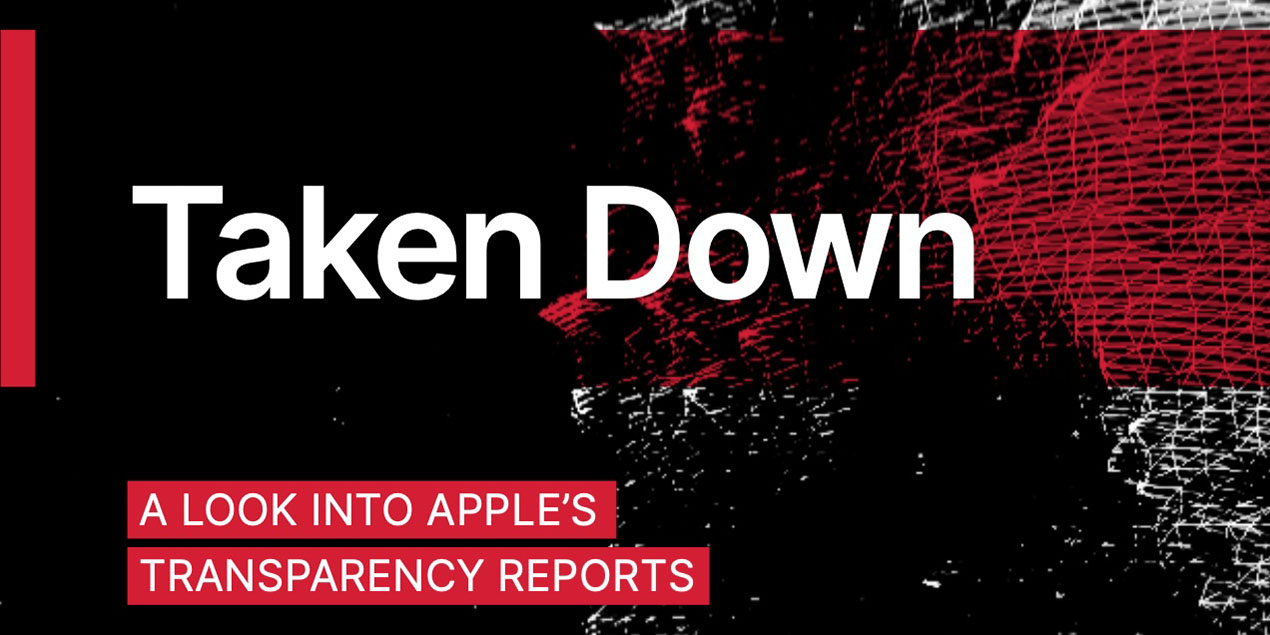
A campaign group has criticized Apple’s twice-yearly transparency reports, saying that in one very important respect they are not very transparent.
One section of the report covers App Store Takedown Requests, and Apple is accused of deliberately concealing information about the apps it removes …
Background
Apple publishes Transparency Reports twice a year. These detail the actions it has taken in response to both government and private data requests, as well as the apps it has removed from the App Store in response to takedown requests.
Apple provides information regarding requests from government authorities to remove apps from the App Store based on alleged/suspected violations of local law. Examples of such requests are where law enforcement or regulatory agencies suspect an app may be unlawful or relate to/contain unlawful content. Apple complies with these requests insofar as we are legally required to do so.
The latest report revealed that the majority of app takedown requests were received from China, and that Apple removed every single one of the apps concerned.
Apple reports that it received 39 legal violations takedown requests covering 206 applications. China accounted for 26 of those requests covering 90 applications, followed by India making six requests covering 102 applications. Apple removed all 206 of the applications requested.
Apple’s transparency reports aren’t, in fact, transparent, says campaign group
The accusation is made by GreatFire, a campaign group whose mission is to “monitor and challenge internet censorship in China.” The group has published its own report, titled “Taken Down: A Look into Apple’s Transparency Reports.”
Apple carefully engineered its Transparency Reports to conceal as much information as possible on app removals from the 175 App Stores it operates worldwide.
Dissecting the four Transparency Reports covering “Worldwide Government App Store Takedown Requests” from January 2019 until December 2020, AppleCensorship uncovered scores of missing data, incoherence and contradictory information presented in the most deceptive way, making it impossible for the public to have a clear understanding of Apple’s government-led and proactive removals of apps from its App Stores. In presenting such reports as its effort to be transparent to the public, Apple is deceiving its users and the public on the reality of its takedown policy, both in terms of its nature and true scale.
AppleCensorship’s report demonstrates that despite the publication of these so-called “transparency” reports; Apple is still operating in the most opaque way, unaccountable for the decisions it takes regarding certain content, information and tools unavailable on the App Store.
The group says that while Apple provides statistics, it fails to provide any of the information that would be required to assess the reasonableness of the app removals.
- No information on the apps being removed, their category, the type of content, and functions they offered, and the App Stores in which they were present before being removed.
- No information on government bodies issuing the takedown requests, the dates of requests, their legal basis, and the reasons invoked by these bodies for app removals.
- Only 10 vague and shortly phrased reasons were used repeatedly by Apple to describe the reasons for app removals: “apps operating without government licence,” “illegal gambling,” and “illegal content” account for 32 out of the 41 brief explanations provided by Apple.
GreatFire says that this makes it impossible to know who was targeted or harmed by the removals.
Since no information is given on the apps being removed, it is impossible to know if certain groups of users (such as Human Rights activists, journalists, ethnic minorities or vulnerable communities such as LGBTQ+) have been targeted by such removal.
Additionally, it says that governments often make takedown requests by reporting apps as being in violation of App Store policies – which avoids the need for them to cite a legal basis for their removal.
Platform Policy Takedown Requests (PPVTR) trigger many more removals than Legal Violation Takedown Requests (LVTR).
Over two years, the 869 apps removed following LVTRs generated 948 removals worldwide, while the 191 apps removed for PPVTRs generated 29,605 removals worldwide. In other words, 96.90% of all removals were made following Apple’s own decisions. Only 3.10% of all removals were made because of Apple’s legal obligation to comply with local laws.
The group says that Apple should provide much more information, including the list of apps removed, and the laws the apps are alleged to have broken.
We’ve reached out to Apple for comment, and will update with any response.
FTC: We use income earning auto affiliate links. More.






Comments